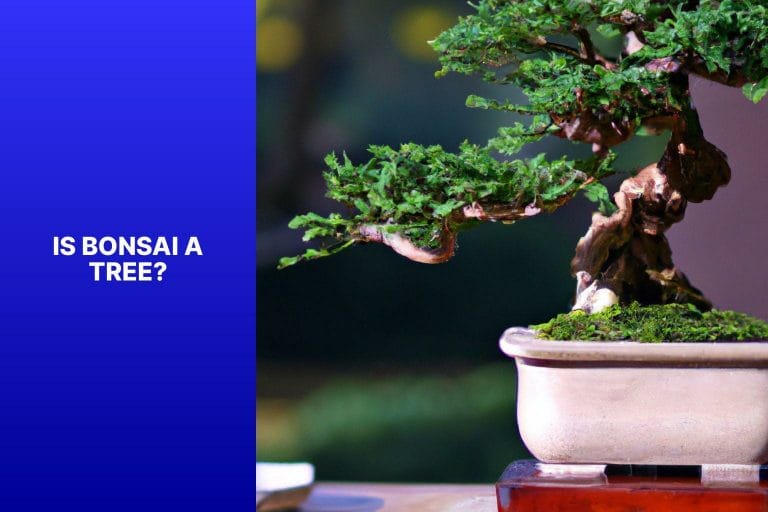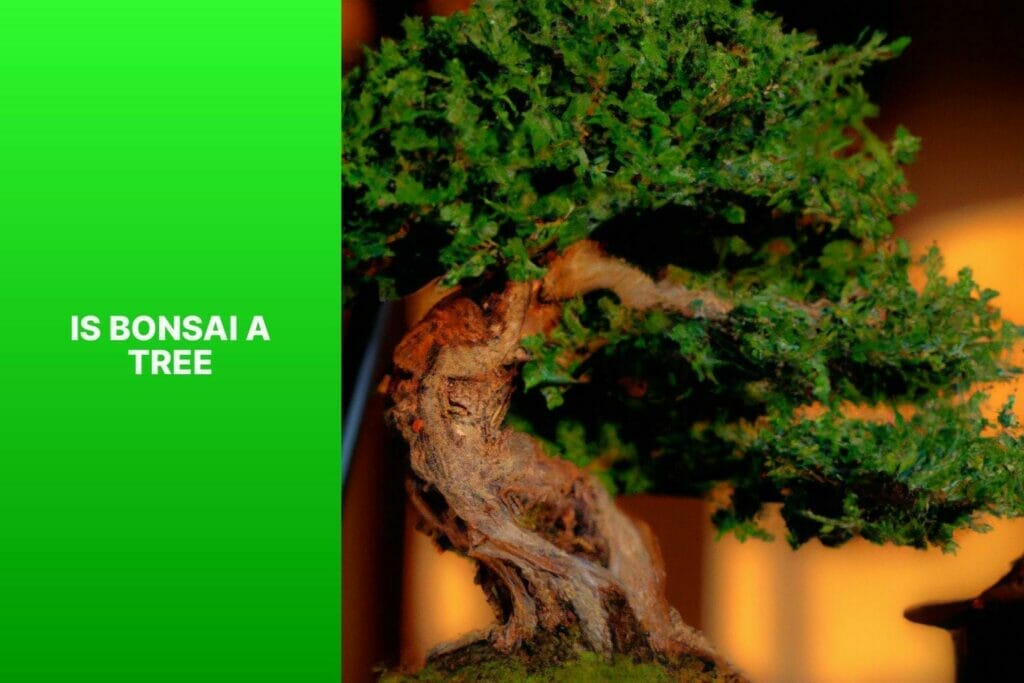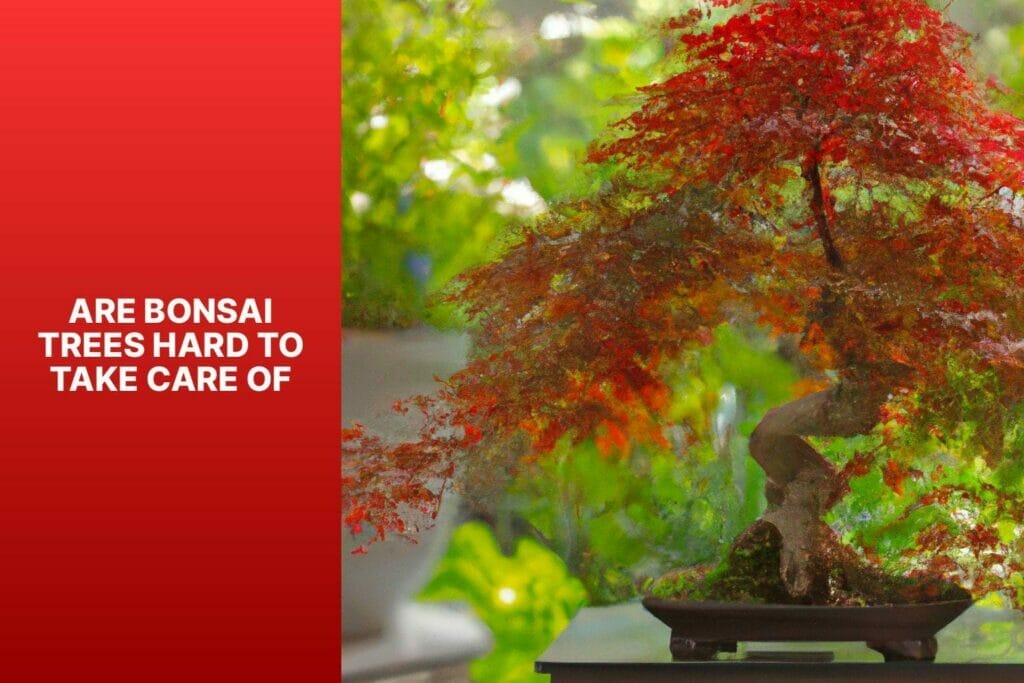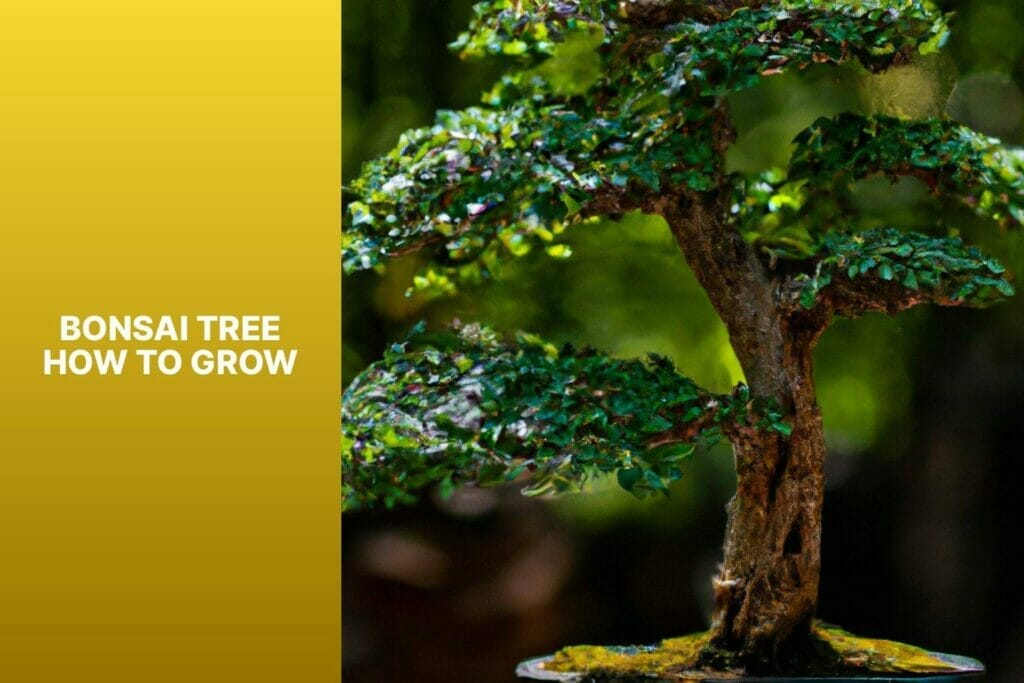Bonsai, a fascinating art form that originated in East Asia, has captured the attention and admiration of people worldwide.
In this article, we will explore the nature of bonsai trees and answer the question, “Is bonsai a tree?” by examining their characteristics and distinguishing them from regular-sized trees.
Bonsai, which translates to “tray planting,” refers to the cultivation of small, aesthetically shaped trees that mimic the appearance of their full-sized counterparts.
These miniature trees are meticulously trained and pruned to maintain a compact size while representing the essence of a mature tree.
When considering if Bonsai is a tree, it is crucial to understand the key characteristics that set Bonsai apart. Bonsai trees possess various defining features, such as their small size, intricate branch structure, and miniature leaves.
They are carefully shaped and wired, allowing for a striking resemblance to fully grown trees on a much smaller scale.
Despite the differences, Bonsai and regular trees share some commonalities. Both bonsai trees and full-sized trees belong to the same species, with the main distinction being the size and form in which they are cultivated.
Bonsai trees also undergo the same biological processes as regular trees, including photosynthesis, respiration, and growth, albeit on a smaller scale.
Exploring the history and origins of Bonsai provides insight into its cultural significance and artistic heritage. Originating in China over a thousand years ago, Bonsai gained popularity in Japan, developing into a refined art form.
The practice of Bonsai reflects principles of balance, harmony, and the appreciation of nature, deeply rooted in Eastern philosophies.
Various types of trees can be used for Bonsai, with specific species favored for their compatibility with the art form.
Trees like Junipers, Pines, Maples, and Ficus are commonly chosen for their aesthetic appeal, ability to withstand pruning and adaptability to miniature cultivation.
Caring for Bonsai requires attention to detail and specific techniques. Proper watering, fertilization, pruning, and wiring are essential for maintaining the health and shape of the tree.
Providing the right environment, including appropriate soil and light conditions, is crucial for Bonsai’s well-being.
Aside from their artistic appeal, bonsai trees bring several benefits. They promote relaxation, mindfulness, and stress reduction to those who practice bonsai cultivation.
Bonsai also symbolizes patience, discipline, and the beauty of nature, embodying harmony between humanity and the natural world.
As we delve into the inBonsai’s intricacies, we will better understand unique art forms, appreciating the skill and artistry required to create and care for these captivating miniature trees.
Key takeaway:
- Bonsai maximizes natural beauty: Bonsai trees are miniature versions of full-sized trees, allowing for cultivating beautiful landscapes in smaller spaces.
- Bonsai requires special care: Bonsai trees require meticulous attention and specific techniques to maintain their shape and size.
- Bonsai reflects history and culture: Rooted in ancient practices, Bonsai showcases the artistry and traditions of different cultures, providing a deeper connection to history and nature.
What is a Bonsai?

Photo Credits: Mnbonsainetwork.Com by Christopher Thomas
Bonsai is a traditional Japanese art form that involves cultivating small trees or plants in containers. This art form requires patience, skill, and a deep understanding of horticulture.
What is a Bonsai? Bonsai is a traditional Japanese art form that involves cultivating small trees or plants in containers. This art form requires patience, skill, and a deep understanding of horticulture.
To create a bonsai, the artist carefully trims the roots, shapes the branches, and controls the growth through regular pruning.
The goal is to create a harmonious balance between the tree’s roots, trunk, branches, and foliage while maintaining the illusion of a mature tree on a smaller scale.
Depending on the species and climate, Bonsai trees can be enjoyed indoors and outdoors. They bring tranquility and natural beauty to any space.
Caring for a bonsai involves watering, fertilizing, and occasional repotting to ensure health.
If you’re interested in starting your own Bonsai, research and select the right species suitable for bonsai cultivation.
Each species has specific sunlight, watering, and temperature requirements. Invest in quality tools and learn proper techniques to shape and maintain your Bonsai.
Remember, Bonsai is a living work of art that requires dedication and passion. Enjoy nurturing and watching your bonsai tree evolve.
Characteristics of Bonsai

Photo Credits: Mnbonsainetwork.Com by George Lopez
The characteristics of bonsai trees can be described in terms of their size, shape, age, and care requirements.
Size: Bonsai trees are miniature trees cultivated to maintain their small size. Depending on the species and style, they can range from a few inches to several feet in height.
Shape: Bonsai trees are pruned and shaped to create specific forms or styles, such as formal upright, informal upright, cascade, or broom. These shapes are achieved through careful trimming and wiring.
Age: Bonsai trees can live long with proper care, and some specimens can be hundreds of years old. The age of a bonsai tree significantly affects its value and appreciation. Is Bonsai a tree
Care requirements: Bonsai trees thrive with specific care. They need regular watering, appropriate sunlight, and proper fertilization. Pruning and wiring are necessary to maintain their desired shape and size.
Fact: Bonsai trees are not a specific type of tree but rather regular trees that are trained and pruned to fit the characteristics of Bonsai. The art of Bonsai has been practiced for centuries, originating in China and later popularized in Japan.
Is Bonsai a Tree?

Photo Credits: Mnbonsainetwork.Com by Steven Clark
Is Bonsai a Tree? Let’s dig into the intriguing world of Bonsai and explore the distinctive qualities that set it apart from regular trees.
We’ll uncover the key differences between Bonsai and their full-sized counterparts, as well as the surprising similarities that connect these miniature marvels to the natural world.
Get ready to embark on a journey that reveals Bonsai’s unique artistry and horticultural wonder!
Differences between Bonsai and Regular Trees
| Differences between Bonsai and Regular Trees | |
|---|---|
| Bonsai | Regular Trees |
| Bonsai trees are intentionally dwarfed and trained to stay small. | Regular trees grow naturally to their full size. |
| Bonsai trees are usually grown in shallow containers or pots. | Regular trees grow in the ground, with deep and wide roots. |
| Bonsai trees need regular pruning and shaping. | Regular trees do not require as much pruning and shaping. |
| Bonsai trees are often grown indoors, allowing for year-round care. | Regular trees are typically grown outdoors and experience seasonal changes. |
| Bonsai trees have a concentrated and intricate branch structure. | Regular trees have a spread-out and natural branch structure. |
| Bonsai trees use techniques to create the illusion of age and maturity. | Regular trees naturally develop age and maturity over time. |
Similarities between Bonsai and Regular Trees
The similarities between Bonsai and regular trees are:
- Growth: Both Bonsai and regular trees grow and develop over time, going through stages of germination, growth, and maturation.
- Root system: Bonsai trees, like regular trees, have root systems that anchor them to the ground and provide water and nutrients.
- Branches and foliage: Bonsai and regular trees have branches and foliage that contribute to the overall aesthetics of the tree.
- Seasonal changes: Bonsai trees, like regular trees, experience sprouting leaves in spring, lush green foliage in summer, color changes in autumn, and dormancy in winter.
- Natural beauty: Bonsai and regular trees possess a natural beauty that brings tranquility and serenity to any environment.
Pro-tip: When caring for a bonsai tree, provide proper sunlight, water, and nutrients. Regularly prune and shape the branches to maintain their desired form.
By understanding and appreciating the similarities between Bonsai and regular trees, you can better care for your Bonsai and showcase its natural beauty.
The similarities between Bonsai and regular trees are:
- Growth: Both bonsai and regular trees grow and develop over time through stages of germination, growth, and maturation.
- Root system: Bonsai trees, like regular trees, have root systems that anchor them to the ground and provide water and nutrients.
- Branches and foliage: Both Bonsai and regular trees have branches and foliage that contribute to the tree’s overall aesthetics.
- Seasonal changes: Bonsai trees, like regular trees, experience sprouting leaves in spring, lush green foliage in summer, color changes in autumn, and dormancy in winter.
- Natural beauty: Bonsai and regular trees possess a natural beauty that brings tranquility and serenity to any environment.
Pro-tip: When caring for a bonsai tree, provide proper sunlight, water, and nutrients. Regularly prune and shape the branches to maintain the desired form.
By understanding and appreciating the similarities between Bonsai and regular trees, you can better care for your Bonsai and showcase its natural beauty.
History and Origins of Bonsai
Bonsai has a fascinating history, and its origins can be traced back to its beginnings in China. It started as a way of creating mini landscapes in pots and eventually made its way to Japan.
The practice of Bonsai was greatly influenced by Zen Buddhism, which added its unique style and techniques.
During the Edo period, Bonsai gained popularity in Japan thanks to the development of specific pruning and shaping techniques. As time went on, Bonsai continued to evolve and spread worldwide during the 19th and 20th centuries.
Today, Bonsai is practiced globally, with different styles and tree species cultivated. It’s incredible that the oldest known bonsai tree, over 1,000 years old, is kept in Japan’s Tokyo Imperial Palace collection.
Delving into the history and origins of Bonsai is truly fascinating, as it allows us to see how this art form has evolved over centuries and gained global popularity.
Types of Trees Used for Bonsai
When it comes to Bonsai, a variety of tree types are commonly used. Let’s explore the diversity of trees that can be incorporated into this art form:
- Pine: One popular choice for Bonsai is the pine tree. Pines have a unique shape and needle-like leaves that make them stand out.
- Juniper: Another common option is the juniper tree. Junipers have a distinctive and rugged appearance with twisted branches and scale-like leaves.
- Maple: Maple trees are highly prized in bonsai compositions for stunning foliage and vibrant colors.
- Chinese Elm: Chinese Elm trees are favored for their adaptability and natural resistance to pests, making them a great choice for Bonsai.
- Crab Apple: Bonsai enthusiasts often choose crab apple trees for their delicate and enchanting blossoms.
- Ficus: The ficus tree is a versatile option that can thrive indoors and outdoors. It features intricate root networks and lush foliage.
Each tree type has unique characteristics, allowing bonsai artists to cultivate various styles and expressions. Ultimately, the choice of the tree depends on personal taste and the desired vision for bonsai creations.
How to Care for Bonsai
Learning how to care for bonsai trees ensures their health and longevity.
- Placement: Finding the proper location for your Bonsai is crucial. It should receive the right balance of sunlight and shade, preferably bright but indirect light.
- Watering: Bonsai trees should be watered when the soil feels slightly dry. It is important to thoroughly water the tree, making sure the entire root system is soaked.
- Fertilizing: Using a balanced bonsai tree fertilizer is recommended. It should be applied monthly during the growing season, following the instructions.
- Pruning: Regular trimming of new growth that distracts from the desired aesthetic is necessary to maintain the Bonsai’s shape and size.
- Wiring: Shaping and training the branches of your Bonsai can be achieved using bonsai wire. It is important to gently wrap the wire around the branches, avoiding damage or constriction.
- Repotting: Bonsai trees should be repotted every two to three years or when the roots fill the current pot. Trimming back the roots and replacing the soil will provide fresh nutrients for the tree.
- Protection: Protecting your Bonsai from extreme temperatures and drafts is vital. During winter, moving the tree to a sheltered location or covering it is advisable.
Following these steps, you can ensure your bonsai tree thrives and remains a beautiful symbol of nature and artistry.
Benefits and Significance of Bonsai
Bonsai has multiple benefits and significant value. Here are some reasons why Bonsai is culturally and horticulturally important:
- Artistic expression: Bonsai allows individuals to express their creativity and artistic skills. They can shape and prune the trees to create unique and beautiful designs.
- Cultivating patience: Caring for Bonsai requires patience and dedication. This practice teaches the value of patience and the rewards of long-term commitment.
- Stress relief: Working with Bonsai reduces stress levels. Nurturing and tending to the tree can provide a sense of calmness and relaxation.
- Connection to nature: Bonsai brings nature into living spaces. A bonsai tree indoors provides tranquility and a connection to the natural world.
- Learning opportunity: Bonsai involves understanding the tree’s needs, such as watering, pruning, and providing the right light. This provides an opportunity to learn about horticulture and plant species’ needs.
Fun fact: The oldest known bonsai tree is over 1,000 years old, demonstrating the longevity and timelessness of this ancient art form.


